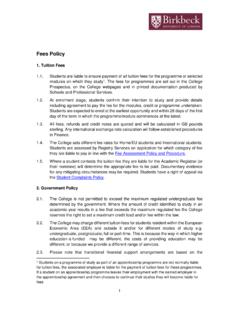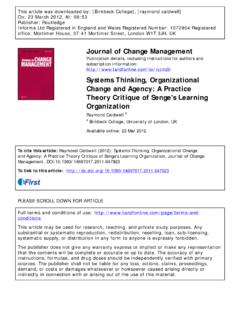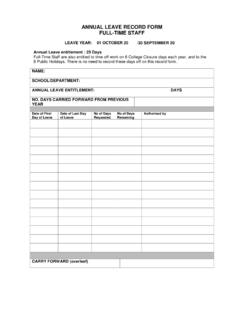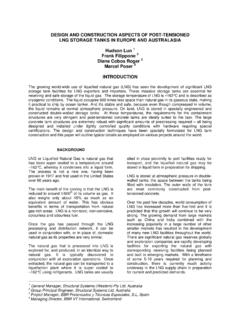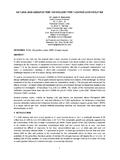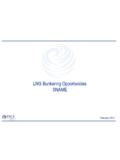Transcription of Valuing and Hedging LNG Contracts
1 Valuing and Hedging LNG. Contracts A Derivative Pricing Approach Robert Doubble BP Oil International Commodities 2007. The LNG Market 1. Industry Context The first commercial LNG trades took place in 1964 between Algeria and Europe, export of North American gas to Japan followed in 1969. In the 1990's the industry expanded with Australian, Arab Gulf (AG), African and North American production serving new markets, eg Korea Most of this gas was contracted on inflexible Long Term Agreements (LTAs) with pricing formulae indexed to oil By 2000 global liquefaction capacity had grown to 115 mTpa with imports totalling 110 mTpa This close match in production and imports was a direct result of project sanctions for LNG infrastructure only being granted once all future production had been sold on LTAs 2.
2 The LNG Market 2. Industry Context Post 2000, with increased liquidity in the US and European markets the Atlantic Basin initiated more flexible contract structures These would allow regional arbitrages and optimisation across a global LNG market In 2005 imports were estimated to be 140 mTpa vs a production capacity of 145 mTpa LNG is changing from a niche, high cost activity focussed on specific markets to a core feature of the global gas balance Demand is expected to grow by ~30%. pa over the next 10 years LNG currently accounts for ~8% of gas demand 3. The LNG Market 3. The Outlook Today Today the global LNG market can be divided into two distinct regions, the Atlantic Basin (AB) and the Pacific Basin (PB).
3 Demand is strongest in countries surrounding the PB with Japan being the largest individual market Growth is expected to be strongest in the regions that surround the AB. LNG markets are still dominated by LTAs but this is changing as more flexibility is built into the markets The emergence of the US as a major market has seen Contracts evolve to allow a greater degree of diversion flexibility across the AB, creating opportunities for regional gas-on-gas arbitrage and optimisation The industry is heavily influenced by the regulatory environment and competition to secure market access is fierce Successful players will be those willing to offer non-traditional contractual arrangements 4.
4 BP's LNG Trading Activities History and Overview BP entered the LNG industry in 1997 through upstream positions in the AG and then Australia The mergers with Amoco and Arco led to positions in the Americas, Africa and Asia The Traded LNG Business Unit within BP is mandated to operate and trade around a web' of supply, end-markets and ships with the aim of creating incremental value BP currently optimises: Equity purchase agreements Merchant supply Contracts Shipping Contracts Delivery obligations to third-parties Regasifcation capacity agreements 5. BP's LNG Portfolio Diversion Value and Trading Strategy BP has a significant portfolio of LNG purchase and sales agreements residing in its trading book BP's shipping fleet allows LNG to be transported from source to any market where regasifcation facilities exist Diversion flexibility offers value since vessels can sail to the most profitable markets LNG Contracts often recognise destination flexibility and embed pricing clauses to capture this value We will consider a toy' contract that embeds some typical price clauses that feature in many modern LNG agreements We will apply a
5 Derivative pricing approach to value the contract and identify the correct Hedging strategy We will see that due to the contractual complexities the appropriate trading strategy can be non-trivial to determine 6. A Toy' LNG Purchase Agreement contract Outline We consider an LNG contract that allows the holder to buy cargoes at regular time intervals The base case is for the LNG to be resold in the US market The holder typically has the right to divert the vessel to the UK, continental Europe or Asia if it is profitable to do so Purchase and sales prices are a function of the cargo destination The vessel destination is nominated in M-1, where month M is the physical delivery month As a starting point we will.
6 Only consider sales in the US and UK markets Assume that each exercise decision is not influenced by earlier decisions This allows us to decompose the contract into a strip of options For this presentation we consider only a single option in the strip 7. Vessel Sails to the US - 1. contract Purchase Price In this case the purchase price is defined to be: Pbase + .DPus [$/mmbtu]. where: Pbase is a US reference (base) price DPus is a US Destination Premium (DP). is a scalar with a typical range of 0 1. The PBase price is defined to be: Pbase = f(HH) RGbase SCbase [$/mmbtu]. where: f(HH) is a Henry Hub linked price RGbase is a reference (base) re-gas cost SCbase is a associated (base) reference shipping cost 8.
7 Vessel Sails to the US 2. contract Purchase Price The DPUS is defined to be: DPus = Max[ADPus Pbase ; 0]. where: ADPus = g(index) RGprem SCprem and: g(index) is a function of a US gas price Index (which need not be HH). RGprem is a regas cost for delivery into a premium' US location SCprem is the shipping cost for delivery into a premium' US location The costs RGbase and RGprem are (typically) functions of a HH-linked price 9. Vessel Sails to the UK. contract Purchase Price If the vessel sails to the UK then the purchase price is: Pbase + .DPuk [$/mmbtu]. where: DPuk = Max[ADPuk Pbase ; 0].
8 Is a scalar with a typical range of 0 1. ADPuk = h(NBP, X) RGuk SCuk and: h(NBP, X) is a price linked to the UK NBP gas and FX markets RGuk is a UK regas cost SCuk is a UK shipping cost 10. Toy contract Analysis Key Pricing Assumptions For ease of exposition I assume the following for the toy contract : Pbase = (t).Avgus[HHi] + (t) [$/mmbtu]. ADPus = (t).Avgus[HHi] + (t) [$/mmbtu]. US sales price = (t).Avgus[HHi] + (t) [$/mmbtu]. ADPuk = (t).X(t).Avguk[NBPi] + (t) [$/mmbtu]. UK sales price = (t).X(t).Avguk[NBPi] + (t) [$/mmbtu]. The coefficients , , , and , and the , , , and are contract and market specific, they also typically display seasonal variation Here Avgus[.]
9 ] and Avguk[.] refer to price averages specific to the US and UK markets and are contract dependent The prices Avgus[HHi], Avguk[NBPi] and X(t) will be defined rigorously later 11. Decomposing the Problem - 1. Vessel Sails to the US. LNG purchase price: = Pbase + .DPus = .Avgus[H(ti)] + + .Max[( ).Avgus[H(ti)] + ; 0]. LNG sales price: = .Avgus[H(ti)] + . where: H(ti) is the closing price at time ti for the NYMEX HH contract corresponding to the physical delivery of gas in month M. Avgus[H(ti)] is the average of the closing prices of the month M HH contract where the averaging window is contractually defined Here we have dropped the time arguments for the coefficients , , , and , and the , , , and to aid clarity 12.
10 Decomposing the Problem - 2. Vessel Sails to the UK. LNG purchase price : = Pbase + .DPuk = .Avgus[H(ti)] + + .Max[ .X(ts).Avguk[I(ti)] - .Avgus[H(ti)] + ; 0]. where: I(ti) is the closing price at time ti of the IPE gas contract for physical delivery in month M at the UK NBP. Avguk[I(ti)] is the average of the closing prices of the month M contract where the averaging window is contractually defined X(ts) is the spot USD/GBP FX price at time ts LNG sales price: = .X(tuk).Avguk[I(ti)] + . Here we are assuming that the GBP cashflows are converted to USD at times ts and tuk 13. Vessel Nomination Time Line IPE, HH and FX Pricing Windows M-2 M-1 M M+1.




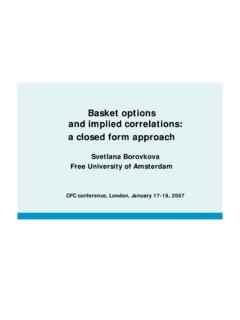
![[Your parent(s)/legal guardian(s) address] Entry …](/cache/preview/d/a/4/2/8/2/9/3/thumb-da428293fc86d7e7b8cebe1132189c1a.jpg)

